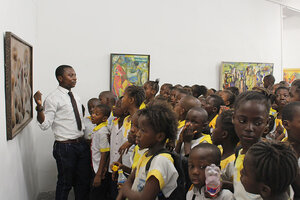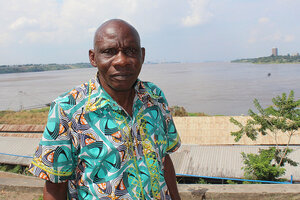In Congo, a new national museum renews quest to reclaim history
Congo's national museum has languished for years, decades after former dictator-president Mobutu Sese Seko built it as part of his quest to redefine the country's identity after colonialism. But perhaps no one knows better than the Congolese how complicated it is to build a country – or a museum.

Students tour the contemporary art museum in Kinshasa, Congo, which has struggled to secure funding.
Ryan Lenora Brown/The Christian Science Monitor
Kinshasa, Congo
In a hilltop park high above Congo’s capital city, Batekele Mabanza Jose sits watch over his country’s history.
All around him, eras of the country’s past are shoved together like layers of metamorphic rock. On one side of the park, vines crawl over the bars of a cage that in the 1970s held one of former President Mobutu Sese Seko’s pet leopards. In another corner, an oversized bronze statue of the Belgian King Leopold II – Congo’s 19th century conqueror – gazes purposefully out over a cracked parking lot.
Nearby, a small complex of warehouses holds the nearly 50,000-item collection of Congo’s national museum, a sprawling mix of paintings, cultural artifacts, and audio recordings documenting the histories and cultures of Congo’s mosaic of ethnic groups.
“This place is the memory of our country,” says Mr. Jose, a curator and tour guide for the museum, as he waits for visitors on a recent Saturday morning.
But as a reservoir for a country’s collective memory, the museum complex has one major downside – it’s been almost entirely forgotten.
Entire days often pass here without a single visitor. The same is true at another branch of the museum at Kinshasa’s Academy of Fine Arts. There, a lone air conditioner rasps as it blows tiny puffs of cool air over a dimly lit room crowded with sparsely labeled masks, weavings, and spears.
“This is what colonization did to us – it cut us off from our traditional culture, it made people forget where they came from,” says Marie Salome Mwemena, the director of that museum, surveying the empty room. “We are like a people with amnesia. We have forgotten our own history.”
But now, the concrete skeleton of a new national museum building is rising on one of Kinshasa’s main boulevards, slotted into prime real estate near the Palais du Peuple, Congo’s parliament, and the country’s national stadium. It’s being bankrolled by the Korea International Cooperation Agency (KOICA), which says it hopes the new museum will encourage more Congolese to engage with the country’s past, and help forge a sense of national unity in a country splintered by violent insurgencies. For many Congolese, meanwhile, the museum project is a hopeful step in their decades-long battle to have tens of thousands of Congolese artifacts repatriated from European and American museums.
But perhaps no one knows better than the Congolese how complicated a project it is to build a country – or for that matter, a national museum. In the 1970s, after all, the flamboyant Mobutu tried to do both. Mobutu’s museum, indeed, was in many ways meant to be a laboratory for Congo itself, says Sarah Van Beurden, an associate professor of African American and African studies at The Ohio State University: intended as a place where the dictator-president could redefine a national identity brutally suppressed by Belgian colonial rule.
And the story of its rise and fall, some observers say, offers a cautionary tale for the new museum, and a reminder that what makes it into a country’s past is very much determined by the goals of those in power in the country’s present.
That was something Mobutu knew well.
“During the colonial period we suffered … from the barbarous, systematic pillaging of all our works of art,” he told the United Nations General Assembly in October 1973, his trademark leopard-skin hat cocked carefully to one side. He was referring to the mass flight of artifacts from the country under Belgian colonial rule – the vast majority of them to the Royal Museum for Central Africa near Brussels. The robbery of these artifacts, he said, had made his country “poor not only economically but culturally.”
And so, he announced to the UN, Congo wanted its history back. And do to that, it created a vast new national museum, one that would bring Congolese back to what he felt were their “authentic” cultural roots – before Western imperialism got in the way.
“Back then we had everything to do our research – vehicles, cameras, money, anything you needed,” says Christian Briki Kond’ji, the director of the contemporary art museum in Kinshasa, who then was a young researcher for the Institute of National Museums. “This was authenticité put into practice,” he says, referring to Mobutu’s broader project to purge the country of foreign influences, including its very name. The dictator-president rechristened Congo as “Zaire,” dropped his own French first name, Joseph-Désiré, and urged his countrymen to do the same.
In those days, he says, the museum’s staff – Belgian and Congolese – would load up their gear into one of the institute’s two Land Rovers and head out from the capital on teeth-rattling dirt roads to the country’s most remote corners, where they purchased tens of thousands of pieces of traditional art, weaponry, musical instruments, and other cultural relics from local communities.
Back in Kinshasa, they meticulously tagged and organized their new collections, which were stored in an old barracks on Kinshasa’s Mont Ngaliema. In a nod to how important the museum was to the president, it backed up onto one of Mobutu’s palaces and his personal zoo. Meanwhile, the president himself was deep in negotiations with Belgian officials to return objects they had taken out of the country during the colonial period.
Then, things began to fall apart.
At the same time as Mobutu was trying to reclaim his country’s history from the Belgians, he was trying to take back its economy as well. By the mid-1970s, he had nationalized most of the country’s foreign-owned companies, doling them out to his friends and political confidantes. Many were quickly pillaged or run into the ground. The country’s economy tumbled.
As government coffers emptied, plans to build a massive new building for the national museum quickly fell by the wayside.
“That was when things really began to decline,” Mr. Kond’ji says.
And it only got worse. As two major wars gripped Congo in the 1990s and early 2000s, valuable pieces began disappearing from its museums and storerooms, only to later appear on international markets. And the presidents who followed Mobutu seemed to have little interest in splashing out on fixing up their museums when so much of the rest of their country – from schools to hospitals to roads – was in an equal state of disrepair.
In 2011, however, the Congolese government struck a deal with KOICA, the Korean development agency. It would fund the construction of a new national museum, as well as help to digitize its collections and train its staff on museum management.
But like the old museum before it, the project has often seemed less about the museum’s contents and more about the performance of building it, says Dr. Van Beurden, the author of a book on the history of Congo’s national museum.
“There’s this idea that just having a museum puts you on the map as a place, that it legitimizes you as a country,” she says. “There’s concern that the museum isn’t going to be so much about its contents as its shell.”
And that worry isn’t just about Congo’s approach to the museum. It’s about South Korea’s as well. As a rising star in the aid world, Seoul wants to show it’s capable not just of handing out sacks of flour or vaccinating children, but also of pulling off a big cultural project like a museum, Dr. Van Beurden says.
“The story they tell about themselves is about a formerly colonized country that has overcome its past to become a highly successful developed nation,” she says. “And they’re using that image to say to the Congolese, you don’t need to work with your old colonial overlords, you can work with us instead.”
Given Congo’s fraught history with European countries like Belgium, that’s a meaningful offer. However, so far the plans for the new museum have been light on many details – like what exactly will be exhibited there, or what the long term plans for funding and maintaining it are. (KOICA declined to comment for this story.)
The museum is expected to open next year, but some speculate the country’s current political turmoil could push that date back. President Joseph Kabila, who has been in office since 2001, has resisted repeated calls to step down after his last term expired at the end of 2016. Since then, the country has been wracked by protests, several of which have been violently put down by the country’s police force.
And although many local museum officials say they’re hopeful the new project will turn out well, they also know better than to rely on government to come through for them.
Kond’ji, of the contemporary arts museum, part of the Institute of National Museums, says he long ago stopped waiting for government to fill his museum’s bank account, and now devotes most of his time to hustling for funding from outside sources like embassies and foundations. And it’s working, he says, at least for now.
On a recent morning, a crowd of schoolchildren toured the contemporary art museum’s current exhibition, a series of paintings and sculptures honoring Congolese women, tucked into a hall beneath the city’s iconic Limete Tower. As they moved from painting to painting, gasping and giggling, one of their teachers explained why she had brought them here.
“Our kids, they need this – they need to see that Congo has art too,” said Diasadila Godelieve. “And it’s fun.”
Back at the national museum complex, meanwhile, Jose, the curator, wandered out of the single, small exhibition hall, where he had just finished his first tour for the day at 3 p.m. He blinked back the white midday light as he locked the door. Then he made his way slowly back to the park’s entrance, where he sat down and once again began to wait.
Tshoper Kabambi contributed reporting.


